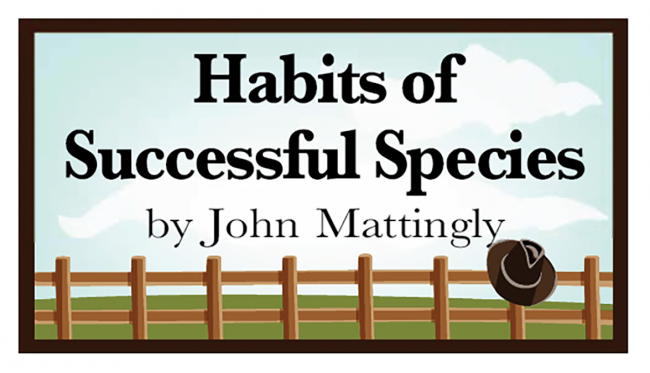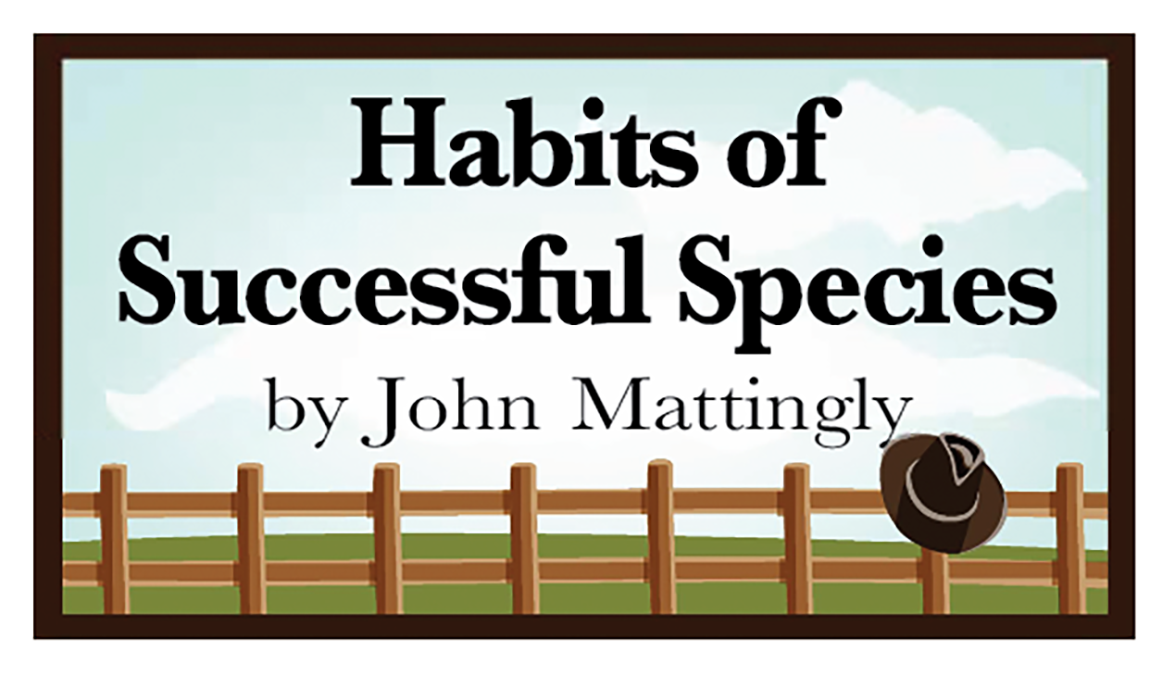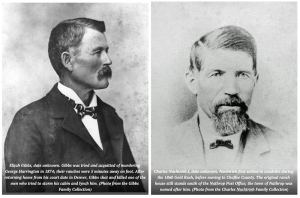
THE ONLY PICTURES I have of coyotes are carcasses, left in the pasture after they got a little too close to the herd where our three guard dogs schooled them as to boundaries. In over 10 years of running a herd of about 300 ewes and nannies with three Great Pyrenees guard dogs — who brought the herd into the barn from pasture every night — our confirmed loss to coyote predation was zero.
Of course, people point out: how would I know, given that coyotes are clever and fast and seldom seen. Point taken. However, we did not find carcasses or bones in the pasture, except in the case of a sick animal — and sheep and goats have a higher herd mortality rate than cattle — in which case the coyotes were there to clean it up.
The desert is a thrifty place where food is consumed quickly. It’s easy to see how coyotes are blamed for killing a poor creature who was prepared for them by human mismanagement, disease, weakness, accident or another predator.
We saw the herd every day as part of our habit of bringing fresh meat to feed the guard dogs (whom we considered the same as valued employees), so we came to recognize certain individuals and families and look to see if any were missing or if any individual was bleating in distress for a missing mother or kid or lamb.
It is possible that a coyote got an occasional lamb or kid. But that would not change my attitude toward coyotes, which is very appreciative of what they do in the desert ecosystem. If left to their own assessment of the local food supply, coyotes will multiply with proportional restraint and feed primarily on mice, rabbits, gophers, grubs, grasshoppers and other creatures in a balanced way. An extensive study of coyote scat revealed over 9,000 different items of intake, including rope and plastic.
Coyotes are very respectful of boundaries, which I periodically enhanced by saving my urine and spreading it along tunnels under fence lines. And coyotes do not like to tangle with big dogs, who are descendants of their arch predator, the wolf.
For confirmation of my experience that, with guard dogs in a herd, coyote predation is minimal, I came across a wonderful book by Dan Flores, “Coyote America” (available in both audio and book form) that presented a thorough history of the relationship between European settlers in the West and coyotes.
While it is true that coyotes are elusive, they are also very in tune with their territory and have survived an extraordinary onslaught from humans by learning from us how to survive. Part of that survival is the ability to educate their young, be fleet and adjust estrus cycles relative to available food.
You would think — after farming and ranching in the north end of the San Luis Valley for the last 35 years and spending most of my working time outside — that I would have a few living coyote portraits. I have none.
Almost every night we hear them yipping nearby, at different points on the compass, the sound increasing or decreasing like a Red Shift distortion as the pack either approached or retreated relative to our house.
I’ve seen a coyote loping along in a field I was working or passing, but, always, by the time I got my phone out and pointed the camera, the coyote was out of sight. One time, I recall driving along a county road and seeing a coyote running in parallel, about half a mile away. Rather than trying to photograph it, I clocked it at about 40 mph, a number confirmed in Flores’ book. Coyotes are among the top five fastest mammals on land, behind cheetahs, hares and pronghorn.
In the Valley livestock community, it was immensely unpopular to have a view of coyotes other than a preference for their extinction. At one time, our county commissioners gave a $10 reward for every coyote ear delivered to the courthouse parking lot on the first Saturday of each month. Some ranchers boasted of stalking a pack or family to their den. When the mother showed her head, they’d blow it in two with a .223 so that the ears flew off without having to be cut.
Friends with long guns frequently asked if they could help us protect the herd by hunting coyotes on the ranch. For years I was OK with it, even though no one ever reported an actual kill despite seeing one or two coyotes, mostly running away at 40 mph. In retrospect, it is hard for me to fathom why people so universally hate coyotes and think nothing of killing them.
Several times, organized hunts were executed by some government agency using helicopters and ground troops to round up the coyotes for execution, a practice we forbade on our ranch after the first time they did it. After that big kill, an event that caused a lot of back-slapping and cheers, the rabbit and mouse populations exploded. The rabbits and hares were so thick, they ate a ring around the base of a haystack and caused the stack to collapse.
And the mice were thick in oat hay bales when we fed. When the bale opened, a grenade of mice exploded, scurrying off like furry shrapnel and startling the herd. Around the house, the mice were more than our seven cats could handle. If we left a five gallon bucket out with a little water in the bottom, it would fill overnight with stranded mice seeking a drink.
Flores’ book recounted similar stories in the West, going back to the 1800s where, in targeted areas, coyotes were poisoned or mass-hunted to near elimination. Plagues of rabbits, mice, grasshoppers and gophers followed. But these were more of a problem for farmers than for ranchers, and the livestock lobby and sport hunting groups had more influence in state legislatures. For almost a century, a scorched earth war was waged on coyotes, with hunting and poisons and traps that killed literally millions of coyotes.
Trappers and poison-setters delighted in recounting how various toxic systems caused the coyotes to suffer and die slowly. They found that if the poison killed quickly, other coyotes learned quickly to avoid it. Better to make the coyote die in an anguish satisfying to the rancher and sport hunter. It is astounding the sheer and shameful sadism directed at coyotes.
The coyote revenge: persistence.
Flores pointed out that when we hear coyotes rhapsodizing at night, they are actually sounding out their territory, getting a sense of how many of their own are in the food web and where the dogs are located. Coyotes yipping at night are ominous and seem threatening, but they are actually what Flores suggested is a kind of genomic-driven radar the pack uses to research the features of its territory.
Personally, the event that turned my opinion of coyotes 180 degrees came on a night when they seemed so close to the house that it sounded like a pack of 50 was preparing to attack us. I got up on the roof with a night vision scope mounted on a loaded .223 and spotted only a mother and three pups about 200 feet away.
The mother and pups looked right at me, their green-red eyes piercing from ghostly frames: fearless, as if reading my intentions. It wasn’t that they were daring me to take a shot, it was that they were saying, “Why shoot us? We are your neighbor. We’re just trying to get along like everyone else.”
I understood then that we were living in this desert together. If there were a newcomer to the ecosystem who might be characterized as an intruder, it might be the mammal at my end of the scope.
Coyotes have been wandering the Americas for perhaps 20,000 years. I’m the descendent of Europeans who came here a couple 100 years ago and displaced the existing predatory regime of megafauna with cattle, sheep and goats. That prior regime itself was displaced by early “Homo sapiens” who came across the land bridge and hunted the mammoths, Irish elk, cave bears, mastodons, big cats, giant sloths, mega bison to extinction — leaving deer, buffalo and coyotes in the wake.
History and experience tell us there is no advantage in betting against coyotes by killing them . Better get along with them and learn from them. They will likely be here — along with mosquitoes — to clean up the aftermath if “Homo sapiens” allow climate change, runaway artificial intelligence or nuclear war to render us extinct.
John cultivates prose, among other things, and was most recently seen near Moffat. Habits of Successful Speciesis sponsored by Cheryl Brown-Kovacic, Larry Kovacic and Clare Brien.



